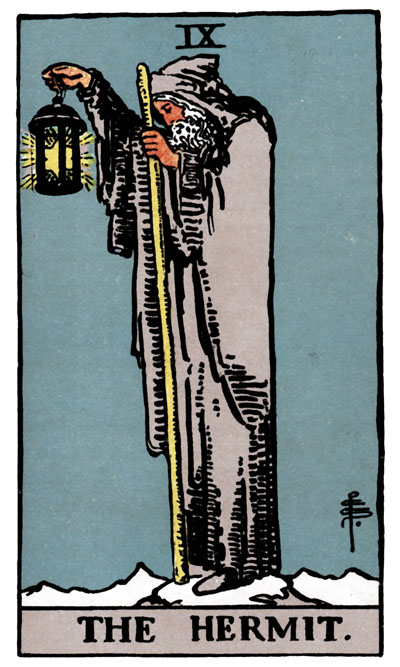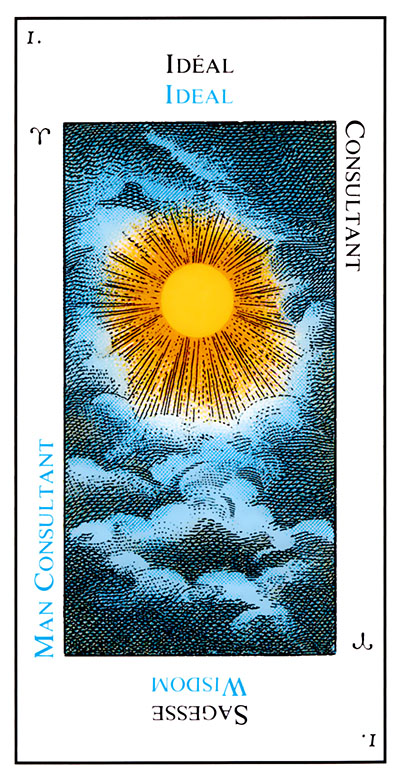Free Computer Tarot Reading
 To consult the cyberspace Tarot cards about a matter, type your query into the box at the bottom of the page (or just leave it blank for a general reading – this is probably the best idea for a beginner) and then click the "Deal the cards" button. A standard layout of ten cards, known as the Celtic Cross layout1, will then be dealt from the Tarot deck.
To consult the cyberspace Tarot cards about a matter, type your query into the box at the bottom of the page (or just leave it blank for a general reading – this is probably the best idea for a beginner) and then click the "Deal the cards" button. A standard layout of ten cards, known as the Celtic Cross layout1, will then be dealt from the Tarot deck.
The Tarot deck consists of 78 cards. There are four suits – Wands (sometimes called Sceptres, Staves, Rods, Sticks or Batons), Cups (sometimes called Chalices), Swords, and Pentacles (sometimes called Discs or Coins). Each suit has "pip cards" numbering from ace (one) to ten, and four court cards – Page, Knight, Queen and King. The cards in these suits are collectively known as the Minor Arcana. An example, the Nine of Swords, is shown below. The remaining 22 cards have no suit and are known as the Major Arcana (or sometimes the Trumps) – The Fool, The Magician, The High Priestess, The Empress, The Emperor, The Hierophant, The Lovers, The Chariot, Strength, The Hermit, Wheel of Fortune, Justice, The Hanged Man, Death, Temperance, The Devil, The Tower, The Star, The Moon, The Sun, Judgement, and The World. An example, The Hermit, is shown on the left/above.
Each of the ten positions in the Celtic Cross layout represents a different relationship between the card dealt to that position and you (the Querent).  For example, the bottom-centre position corresponds to "Recent Past Events"; the second position up from the bottom on the right corresponds to "Environmental Factors", and so on. Each card can be dealt either upright or reversed (upside down). Additionally, having poker-style pairs, three-of-a-kinds, or four-of-a-kinds in your layout adds yet extra meanings!
For example, the bottom-centre position corresponds to "Recent Past Events"; the second position up from the bottom on the right corresponds to "Environmental Factors", and so on. Each card can be dealt either upright or reversed (upside down). Additionally, having poker-style pairs, three-of-a-kinds, or four-of-a-kinds in your layout adds yet extra meanings!
Once the layout is dealt, you can then click on each card to find out the interpretation of the card as dealt to that position. The interpretation is given as a number of keywords or short phrases – the Divinatory Meanings. Mouse users (as opposed to touchscreen users) need only hover over a card for the meanings to pop up in a box. However, clicking on a card gives extra information such as a description of the imagery and an enlarged reproduction of the card.
Background
The divinatory meanings (and card descriptions) I have used come from Arthur Edward Waite's The Pictorial Key to the Tarot, published in 1911 – probably the most famous and definitive work on the Tarot, still widely available today in both print and internet forms2.  Judging by his written work, Waite was a little bit … odd and not exactly given to brevity or clarity of expression (read his Pictorial Key and you'll see what I mean), so his divinations may strike a modern reader as a bit obtuse. But, as one of the "godfathers" of modern Tarot, as it were, he is probably the closest we have to an "official" source. (Other works are available elsewhere if you want something a bit more down to earth.)
Judging by his written work, Waite was a little bit … odd and not exactly given to brevity or clarity of expression (read his Pictorial Key and you'll see what I mean), so his divinations may strike a modern reader as a bit obtuse. But, as one of the "godfathers" of modern Tarot, as it were, he is probably the closest we have to an "official" source. (Other works are available elsewhere if you want something a bit more down to earth.)
A second source for Divinatory Meanings comes from an earlier, similar work called The Tarot by SL MacGregor Mathers, published in 1888. I have given Mathers' comments in green; Waite's in blue. You can follow one set of meanings, the other, or both.
As part of his work, Waite commissioned artist Pamela Colman Smith to produce an entirely new deck of cards under his supervision. If you've ever seen a deck of Tarot cards used on TV or film, it is highly likely to be the one Smith designed (or at least a close copy). Her deck has become legendary – whole books have been written about this one set of cards. The Smith deck was the first English deck to have bespoke designs for all the cards; previous decks had resorted to generic designs for the Minor Arcana. Each card is alive with esoteric imagery and I recommend the book Secrets of the Waite-Smith Tarot by Katz & Goodwin if you want to find out about some of the inspirations and hidden meanings behind the pictures.
The secondary card images are taken from the striking Grand Etteilla deck, reputedly designed by 18th-century French occultist Jean-Baptiste Alliette, the first card of which is shown on the left, above. Alliette changed a few of the Major Arcana to suit himself, so the correspondences between his cards and those of the Waite-Smith pack – at least in pictorial terms – vary in several instances.
Have fun, and don't take it too seriously!
1 There are many variants of this spread – the one used on this site is one of the more common ones.
2 In fact, about 70% of Waite's book (viz. the divinations and descriptions of the cards) is included in this site (all served from back-end databases).
Comments etc. – email: (Click to see e-mail address)


